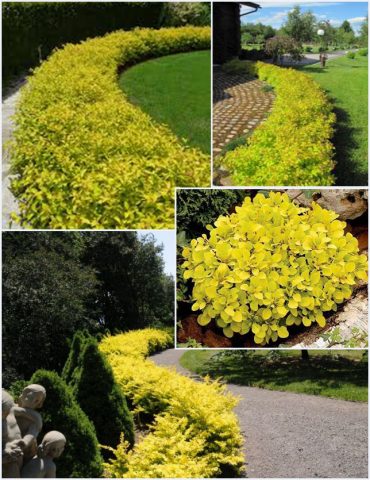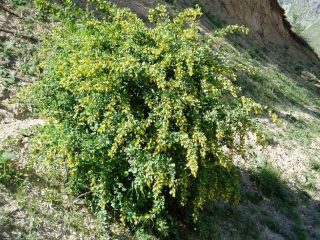Content
With the development of landscape design, gardeners are paying more and more attention to growing ornamental varieties of different crops. The southern species of barberry shrub Aurea is among the first of these crops. Its unpretentiousness to environmental conditions makes it possible to grow shrubs in any Russian region without making much effort.
Description of Barberry Aurea
The decorative thorny shrub Thunberg barberry Aurea in its description has the main difference from other Thunberg barberries in color - lemon yellow.
Otherwise, the description fits the other types of this variety:
- at an adult age, approximately 10 years, it is shaped like a bright yellow hemisphere, grows up to 1 m in height, and up to 1.2 m in width;
- the main stems grow vertically, the lateral ones - at an angle to the main ones, which makes the bush spherical in shape;
- shoots are yellowish-green in color with sparse thorns, densely covered with elongated leaves up to 2 cm long;
- The flowers are small, inconspicuous white flowers, collected in inflorescences of 3-5 pieces, open at the end of May, hiding among the dense foliage.
The lemon-yellow leaves of Barberry Thunberg Aurea are subtly added red in the fall, and the shrub turns orange-yellow in late August. In October, in place of the flowers, numerous shiny fruits of a dark red color and elongated shape appear. Inedible fruits remain hanging on bare branches until the end of winter. This winter type of Aurea barberry decorates the garden plot in a festive way.
Barberry Thunberg Aurea is not picky about climatic conditions and soil conditions. The shrub is drought-resistant and tolerates frost well.
Barberry Aurea in landscape design
The main use of barberry Aurea is decorative. The shrub has become widespread as part of a composite tree and shrub composition in landscape design in gardens, parks, personal plots, and on the banks of a reservoir. The yellow color of Barberry aurea creates a contrast with the surroundings and enlivens the area, attracting attention to itself.
Bright inclusions of their varied colors are created by bushes of Thunberg Aurea barberry of different varieties, if they are planted in one area one at a time or in groups, as seen in the photo.
Barberry Aurea tolerates urban pollution well, so it is often planted to decorate city parks and streets, and create low hedges and borders.
Planting and caring for barberry Thunberga Aurea
The ornamental shrub barberry Aurea comes from Asian countries (China, Japan), but is widely valued by gardeners in other regions of the Earth for its endurance to weather and climatic conditions. You can grow barberry aurea in many Russian regions; planting and care are almost the same as for most shrubs.
Preparing seedlings and planting area
This southern shrub is very light-loving. However, experienced gardeners advise choosing a place for planting so that the plant does not get sunburned and at the same time is not constantly in the shade, otherwise its foliage will lose its brightness. Also, on Russian territory, it is better to plant Thunberg's barberry Aurea where there are no drafts.
If the soil is acidic, then liming is carried out before planting: 300 g of slaked lime is diluted in a bucket of water and the area is watered. In the future, this must be done regularly.
The roots of barberry Thunberg Aurea seedlings should not be dry when planting. They are slightly soaked by placing them in a container of water. If the seedling was in a pot before planting, then it is separated from the container along with the soil and watered with water so that the roots and soil are moist.
Landing rules
Aurea barberry should be planted in a permanent place in early spring - immediately after the snow melts or in the fall - just before the onset of frost. The planting sequence is the same as for many shrubs.
- At the selected location, dig a hole measuring 0.5 m in diameter and 0.5 m in depth.
- A few centimeters of drainage is arranged in the hole by placing coarse sand, broken bricks or small stones there.
- A fertile mixture of humus, sand and soil from the site is poured onto the bottom in a ratio of 1:1:2 and watered with a little water to keep it moist.
- The seedling is planted in a hole and sprinkled with substrate to such a level that the neck of the seedling is at the level of the ground surface.
If a hedge is grown, then when forming a dense wall, 4-5 bushes are planted per 1 m; for free-growing, 2 bushes are enough. After planting, mulch is poured around the bush in the form of cut pieces of tree bark, small pebbles, dry grass, and wood ash.
Watering and fertilizing
In normal weather, barberry Thunberg Aurea needs 1 bucket of water per week. If there is a drought, watering must be done more often so that the soil does not become dry.
Barberry is undemanding when it comes to fertilizers, but will respond well if fertilizing is carried out according to the rules:
- The first application of nitrogen fertilizers is done in the spring a year after planting the bush;
- 20-25 g of urea are diluted in a bucket of water and poured into the trunk circle of one bush;
- further fertilizing is carried out once every 3-4 years.
With care, the tree trunk circle is periodically loosened, going deeper by about 3 cm. It is also advisable to regularly mulch the tree trunk circle.
Trimming
The barberry bush Thunberg Aurea is trimmed for the first time 3 years after planting. This is done in the spring, cutting off poorly developed shoots, dry and frozen stems. This is the so-called sanitary pruning. It is carried out as needed.
Decorative and shaping haircuts are carried out 2 times a year - in early June and in the first half of August. If the bush is grown with a natural crown, then it does not need pruning.
Preparing for winter
Young bushes up to 3 years of age are covered with spruce branches or fallen leaves for the winter. This should be done when the air temperature during the day does not rise above 5-70 C, and the ground has already begun to freeze at night.
Reproduction
The most common methods of propagation of barberry Thunberg Aurea are seed and green cuttings.
A high yield of seedlings during seed propagation is obtained during autumn sowing. This process does not contain anything special and proceeds as for most shrub crops:
- ripe fruits are collected, squeezed through a sieve, washed and dried;
- in the fall, sow in prepared loose and moist soil to a depth of 1 cm;
- spring sowing is carried out in the same way, but after 3 months of stratification.
Both seeds and seedlings can be bought in the store. Before planting, they will have to undergo stratification.
For propagation by dividing the bush, 3-5 year old plants with shallow planting are well suited. The plant is dug up, carefully divided with pruning shears and planted in a new place. This method is rarely used.
Most Aurea barberries are propagated by green cuttings, cutting off strong green shoots of the current year. The shoot should have 2 nodes and 1 internode. The cuttings are planted in boxes with a soil mixture of peat and sand, where they will grow for 1-2 years until they become capable of transplanting.
Diseases and pests
Gardeners consider Barberry Thunberg Aurea resistant to various fungal diseases and pests. But it is not recommended to leave the plant without attention, since there are several diseases that only barberries suffer from:
- powdery mildew is caused by a fungus of the microsphere genus;
- leaf spot manifests itself in different ways and is caused by different fungi;
- barberry aphids can cause the entire plant to dry out;
- Leaf rust causes leaves to dry out and fall off;
- the flower moth destroys the fruits;
- The barberry sawfly eats the leaves.
Powdery mildew is considered one of the most common diseases of barberry Aurea. The leaves and stems of barberry are covered with a white coating on all sides, and if you do not start treating the crop on time, the entire bush will be affected.
To prevent this and other fungal diseases, Aurea barberry bushes are sprayed in the spring with special fungicides before flowering and then the procedure is repeated as necessary. Insecticides are used against pests as soon as they are detected.
Conclusion
Barberry Aurea is an ornamental shrub variety. Landscape designers use it with great pleasure as an important element for the design of gardens, parks, and personal plots. Every amateur gardener who is familiar with the basic rules of growing shrubs can grow Thunberg's barberry Aurea.



















